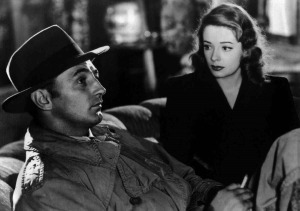
In the 1940s and 1950s, a new genre of film began to filter out of Hollywood. It was a hard-bitten, cynical genre, dealing with themes that movies had not dealt with before. It’s often said that jazz is the only truly unique American art form. This is not exactly true. Film noir is a cinematic genre that was created in America, and has been copied elsewhere extensively around the world.
But what is film noir? It’s difficult to define precisely. But when you see it, you recognize it for what it is. It can be a genre, a style, or a motif. It is often confused with the action genre, the thriller genre, and the crime drama. While these types of movies can incorporate noir themes in them, they are not really noir films per se. A proper noir film has to have a certain thematic spirit to it. It needs a certain darkness, a certain heaviness. What matters is the overall “spirit” of the film. What is its message? What impression lingers on the viewer’s brain? All noir films deal with at least a few of the following themes:
Existential crises torment the main character
Self-destructive actions are a compulsive necessity
Alienation from other people in society
Feminine betrayal in one form or another is more or less inevitable
Sexual thrills come with a cost
The impossibility of escaping one’s character or fate
A universe of moral ambiguity, where good often loses to evil
Bad results usually come from good intentions
To see what I mean, see any of the following films: Chinatown, After Dark My Sweet, The Long Goodbye, The Maltese Falcon, The Conversation, Croupier, Memento, The Third Man, Double Indemnity, Kiss Me Deadly, Le Samourai, Out of the Past, Vertigo. If you’re interested in the genre, you need to check out a few of these classics. There are hundreds of noir films, and these are just a taste.
The “classical period” of film noir straddles the years from 1941 to about 1960. The Maltese Falcon, film scholars tell us, is generally considered to be the first film of the genre. After the 1950s petered out, the art form was put into hibernation in the 1960s and 1970s, only to reappear in the cynical 1990s in the form of “neo-noir.” Neo-noir is still going strong today. There are a great number of them, but some of the best examples are The Spanish Prisoner, The Usual Suspects, Cutter’s Way, Sexy Beast, Road To Perdition, The Pledge, Oldboy, Only God Forgives, La Femme Nikita, Memento…the list goes on and on.
The genre can be traced to the feelings of disillusionment and dislocation that upset American society after the Second World War. The war changed everything, turning conventional morality on its head. Nobody really knew how to cope with the vastly changed landscape that war and social turbulence had created. With the world in chaos, the only safe refuge seemed to be a detached, cynical view of things, as a sort of protective shield.

The mood of the times helped as well. The postwar years, and the Cold War that immediately followed, were characterized by feelings of paranoia, dread, and insecurity. Dark times called for dark themes. Noir films also had the advantage of being relatively cheap to produce. Studios originally shied away from noir, then reluctantly embraced it one they realized that there was a market for it.
Many great Hollywood writers were blacklisted and could only find work by writing apparently shallow cop dramas or crime thrillers. But these same writers managed to embed profound moral ideas in their screenplays. The crime thriller was able to rise above its conventions, and explore territory that it had never explored before.
The French were the first to recognize film noir as a legitimate genre. French critics were deeply impressed by the wave of films coming out of America in the 1940s and 1950s that had dark themes and pessimistic views of the world. And perhaps this is what found a receptive audience in a France that had undergone the serious trauma of the Second World War.
Noir continues to be relevant today because we are dealing with the same themes described above: alienation, being trapped by Fate, moral ambiguity, and the perverse pleasure of self-destructive acts. Every person is forced to grapple with these dark ideas during his life. No one is exempt. And in some strange way, how noir characters deal with their struggles can be inspiring. Many of them have a stoic resolution, and an ironic detachment, which is often the only way to deal with an impossible situation.
Of all the Europeans, it is the French who have embraced it most fervently. Directors like Jean Luc Godard and Jean Pierre Melville, for example, were deeply impressed by American noir and allowed it to influence their own work. Noir has resonance for us today. Its themes harmonize well with the times, I think. If you haven’t seen a few of these movies, you’re missing out.
To learn more about this and similar subjects, read Pantheon.

You must be logged in to post a comment.